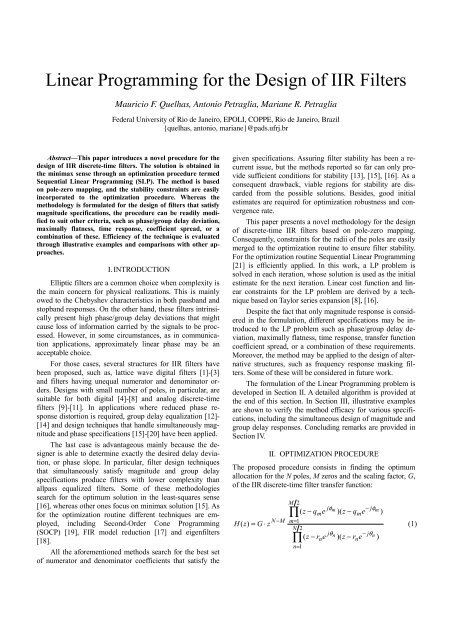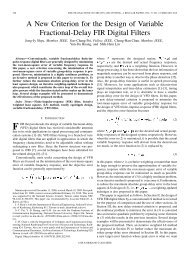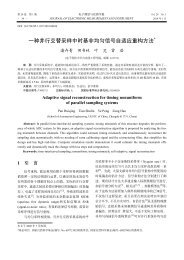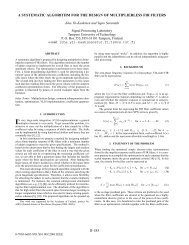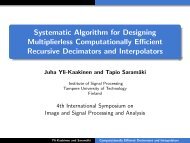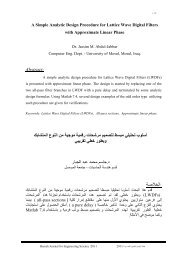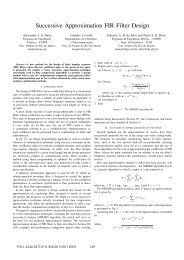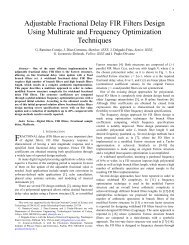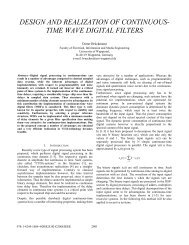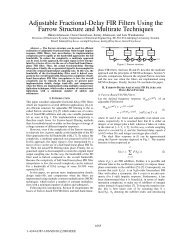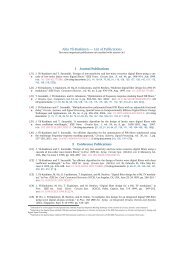Linear Programming for the Design of IIR Filters - IEEE Xplore
Linear Programming for the Design of IIR Filters - IEEE Xplore
Linear Programming for the Design of IIR Filters - IEEE Xplore
You also want an ePaper? Increase the reach of your titles
YUMPU automatically turns print PDFs into web optimized ePapers that Google loves.
<strong>Linear</strong> <strong>Programming</strong> <strong>for</strong> <strong>the</strong> <strong>Design</strong> <strong>of</strong> <strong>IIR</strong> <strong>Filters</strong><br />
Mauricio F. Quelhas, Antonio Petraglia, Mariane R. Petraglia<br />
Federal University <strong>of</strong> Rio de Janeiro, EPOLI, COPPE, Rio de Janeiro, Brazil<br />
{quelhas, antonio, mariane}@pads.ufrj.br<br />
Abstract—This paper introduces a novel procedure <strong>for</strong> <strong>the</strong><br />
design <strong>of</strong> <strong>IIR</strong> discrete-time filters. The solution is obtained in<br />
<strong>the</strong> minimax sense through an optimization procedure termed<br />
Sequential <strong>Linear</strong> <strong>Programming</strong> (SLP). The method is based<br />
on pole-zero mapping, and <strong>the</strong> stability constraints are easily<br />
incorporated to <strong>the</strong> optimization procedure. Whereas <strong>the</strong><br />
methodology is <strong>for</strong>mulated <strong>for</strong> <strong>the</strong> design <strong>of</strong> filters that satisfy<br />
magnitude specifications, <strong>the</strong> procedure can be readily modified<br />
to suit o<strong>the</strong>r criteria, such as phase/group delay deviation,<br />
maximally flatness, time response, coefficient spread, or a<br />
combination <strong>of</strong> <strong>the</strong>se. Efficiency <strong>of</strong> <strong>the</strong> technique is evaluated<br />
through illustrative examples and comparisons with o<strong>the</strong>r approaches.<br />
I. INTRODUCTION<br />
Elliptic filters are a common choice when complexity is<br />
<strong>the</strong> main concern <strong>for</strong> physical realizations. This is mainly<br />
owed to <strong>the</strong> Chebyshev characteristics in both passband and<br />
stopband responses. On <strong>the</strong> o<strong>the</strong>r hand, <strong>the</strong>se filters intrinsically<br />
present high phase/group delay deviations that might<br />
cause loss <strong>of</strong> in<strong>for</strong>mation carried by <strong>the</strong> signals to be processed.<br />
However, in some circumstances, as in communication<br />
applications, approximately linear phase may be an<br />
acceptable choice.<br />
For those cases, several structures <strong>for</strong> <strong>IIR</strong> filters have<br />
been proposed, such as, lattice wave digital filters [1]-[3]<br />
and filters having unequal numerator and denominator orders.<br />
<strong>Design</strong>s with small number <strong>of</strong> poles, in particular, are<br />
suitable <strong>for</strong> both digital [4]-[8] and analog discrete-time<br />
filters [9]-[11]. In applications where reduced phase response<br />
distortion is required, group delay equalization [12]-<br />
[14] and design techniques that handle simultaneously magnitude<br />
and phase specifications [15]-[20] have been applied.<br />
The last case is advantageous mainly because <strong>the</strong> designer<br />
is able to determine exactly <strong>the</strong> desired delay deviation,<br />
or phase slope. In particular, filter design techniques<br />
that simultaneously satisfy magnitude and group delay<br />
specifications produce filters with lower complexity than<br />
allpass equalized filters. Some <strong>of</strong> <strong>the</strong>se methodologies<br />
search <strong>for</strong> <strong>the</strong> optimum solution in <strong>the</strong> least-squares sense<br />
[16], whereas o<strong>the</strong>r ones focus on minimax solution [15]. As<br />
<strong>for</strong> <strong>the</strong> optimization routine different techniques are employed,<br />
including Second-Order Cone <strong>Programming</strong><br />
(SOCP) [19], FIR model reduction [17] and eigenfilters<br />
[18].<br />
All <strong>the</strong> a<strong>for</strong>ementioned methods search <strong>for</strong> <strong>the</strong> best set<br />
<strong>of</strong> numerator and denominator coefficients that satisfy <strong>the</strong><br />
given specifications. Assuring filter stability has been a recurrent<br />
issue, but <strong>the</strong> methods reported so far can only provide<br />
sufficient conditions <strong>for</strong> stability [13], [15], [16]. As a<br />
consequent drawback, viable regions <strong>for</strong> stability are discarded<br />
from <strong>the</strong> possible solutions. Besides, good initial<br />
estimates are required <strong>for</strong> optimization robustness and convergence<br />
rate.<br />
This paper presents a novel methodology <strong>for</strong> <strong>the</strong> design<br />
<strong>of</strong> discrete-time <strong>IIR</strong> filters based on pole-zero mapping.<br />
Consequently, constraints <strong>for</strong> <strong>the</strong> radii <strong>of</strong> <strong>the</strong> poles are easily<br />
merged to <strong>the</strong> optimization routine to ensure filter stability.<br />
For <strong>the</strong> optimization routine Sequential <strong>Linear</strong> <strong>Programming</strong><br />
[21] is efficiently applied. In this work, a LP problem is<br />
solved in each iteration, whose solution is used as <strong>the</strong> initial<br />
estimate <strong>for</strong> <strong>the</strong> next iteration. <strong>Linear</strong> cost function and linear<br />
constraints <strong>for</strong> <strong>the</strong> LP problem are derived by a technique<br />
based on Taylor series expansion [8], [16].<br />
Despite <strong>the</strong> fact that only magnitude response is considered<br />
in <strong>the</strong> <strong>for</strong>mulation, different specifications may be introduced<br />
to <strong>the</strong> LP problem such as phase/group delay deviation,<br />
maximally flatness, time response, transfer function<br />
coefficient spread, or a combination <strong>of</strong> <strong>the</strong>se requirements.<br />
Moreover, <strong>the</strong> method may be applied to <strong>the</strong> design <strong>of</strong> alternative<br />
structures, such as frequency response masking filters.<br />
Some <strong>of</strong> <strong>the</strong>se will be considered in future work.<br />
The <strong>for</strong>mulation <strong>of</strong> <strong>the</strong> <strong>Linear</strong> <strong>Programming</strong> problem is<br />
developed in Section II. A detailed algorithm is provided at<br />
<strong>the</strong> end <strong>of</strong> this section. In Section III, illustrative examples<br />
are shown to verify <strong>the</strong> method efficacy <strong>for</strong> various specifications,<br />
including <strong>the</strong> simultaneous design <strong>of</strong> magnitude and<br />
group delay responses. Concluding remarks are provided in<br />
Section IV.<br />
II. OPTIMIZATION PROCEDURE<br />
The proposed procedure consists in finding <strong>the</strong> optimum<br />
allocation <strong>for</strong> <strong>the</strong> N poles, M zeros and <strong>the</strong> scaling factor, G,<br />
<strong>of</strong> <strong>the</strong> <strong>IIR</strong> discrete-time filter transfer function:<br />
H ( z)<br />
= G ⋅ z<br />
N −M<br />
M 2<br />
∏<br />
m=<br />
1<br />
N 2<br />
∏<br />
n=<br />
1<br />
( z − q<br />
m<br />
jφ<br />
e m )( z − q<br />
jθ<br />
( z − r e n )( z − r e<br />
n<br />
− jφm<br />
me<br />
− jθn<br />
n<br />
)<br />
)<br />
(1)
such as to satisfy <strong>the</strong> magnitude response specifications:<br />
passband edge frequency (ω p ) and ripple (δ p ), stopband edge<br />
frequency (ω s ) and attenuation (δ s ).<br />
To achieve high stopband attenuation, <strong>the</strong> zeros can be<br />
allocated on <strong>the</strong> unit circle by simply setting q m<br />
= 1, m = 1,<br />
2, …,M/2. The exception is <strong>for</strong> filters that have a number <strong>of</strong><br />
zeros much higher than that <strong>of</strong> poles, in which case <strong>the</strong> introduction<br />
<strong>of</strong> zeros in <strong>the</strong> passband is necessary to avoid <strong>the</strong><br />
extra-ripple response [6]-[8]. For this reason, <strong>the</strong> following<br />
equations will be written in terms <strong>of</strong> q m<br />
.<br />
For conciseness <strong>of</strong> presentation, <strong>the</strong> filters are assumed<br />
to have even numbers <strong>of</strong> poles and zeros, as implied by (1).<br />
It should be noted, however, that this <strong>for</strong>mulation introduces<br />
no loss <strong>of</strong> generality, since <strong>the</strong> equations can be straight<strong>for</strong>wardly<br />
rewritten to include odd numerator and denominator<br />
orders. As a result, <strong>the</strong> optimization procedure has N + M/2<br />
+ 1 unknown parameters, comprising one scaling factor, N/2<br />
radii <strong>of</strong> poles, N/2 angles <strong>of</strong> poles, and M/2 angles <strong>of</strong> zeros.<br />
Since <strong>the</strong> magnitude response evaluated at a frequency ω k<br />
<strong>of</strong><br />
a <strong>IIR</strong> filter<br />
h<br />
k<br />
jω<br />
= H ( e k )<br />
(2)<br />
is a nonlinear function <strong>of</strong> those parameters, a Taylor series<br />
expansion is used [7], [8], such as to obtain <strong>the</strong> linear approximation<br />
h h ∇ h<br />
(3)<br />
T<br />
k<br />
≈<br />
k,0 +<br />
k,0 ⋅Δp<br />
on a grid <strong>of</strong> K points along <strong>the</strong> bands <strong>of</strong> interest. Equation<br />
(3) also defines <strong>the</strong> optimization recursion scheme, in which<br />
h k,0<br />
is <strong>the</strong> magnitude response be<strong>for</strong>e an update has been<br />
per<strong>for</strong>med, <strong>the</strong> vector Δp is defined as p – p 0<br />
, where p = [G,<br />
r l<br />
, θ l<br />
, q l<br />
, φ l<br />
] T and p 0<br />
= [G 0<br />
, r l,0<br />
, θ l,0<br />
, q l,0<br />
, φ l,0<br />
] T , and <strong>the</strong> gradient<br />
vector is<br />
⎡∂hk ∂hk ∂hk ∂hk ∂h<br />
⎤<br />
k<br />
∇ hk<br />
,0<br />
= ⎢ ⎥ (4)<br />
⎣∂G ∂rn ∂θn ∂qm ∂ϕm<br />
⎦<br />
T<br />
hk<br />
= hk,0<br />
<strong>for</strong> n = 1, 2, …, N/2 and m = 1, 2, …, M/2.<br />
As mentioned previously, <strong>the</strong> objective <strong>of</strong> this work is to<br />
find <strong>the</strong> optimum <strong>IIR</strong> filter in <strong>the</strong> minimax sense. Accordingly,<br />
a sequential linear programming (LP) algorithm is<br />
applied to find <strong>the</strong> optimum set <strong>of</strong> parameters <strong>of</strong> <strong>the</strong> <strong>IIR</strong><br />
filter that minimizes <strong>the</strong> cost function<br />
= max w d − h<br />
δ k k k<br />
(5)<br />
where w k<br />
is a weighting factor and d k<br />
is <strong>the</strong> desired magnitude<br />
response at ω k<br />
. Equivalently,<br />
δ<br />
≤ dk<br />
w<br />
k<br />
− h<br />
k<br />
δ<br />
≤<br />
w<br />
− (6)<br />
which are <strong>the</strong> constraints <strong>of</strong> <strong>the</strong> following dual-<strong>for</strong>m linear<br />
programming problem : find <strong>the</strong> filter parameters and response<br />
deviation, such as to maximize<br />
ρ = −δ<br />
(7a)<br />
k<br />
subject to<br />
T δ<br />
−∇<br />
h ⋅Δp<br />
− ≤−e<br />
∇<br />
k,0 k,0<br />
w1<br />
h<br />
δ<br />
⋅Δp<br />
− ≤e<br />
T<br />
k,0 k,0<br />
w1<br />
(7b)<br />
<strong>for</strong> k =1, 2, …, K. In <strong>the</strong> above <strong>for</strong>mulation, <strong>the</strong> a priori error<br />
e k,0<br />
is <strong>the</strong> difference between <strong>the</strong> desired and <strong>the</strong> magnitude<br />
response be<strong>for</strong>e <strong>the</strong> update d k<br />
– h k,0<br />
takes place.<br />
The linear set <strong>of</strong> constraints (7b) results from a Taylor<br />
series approximation, as in (3), which holds <strong>for</strong> small deviations<br />
on <strong>the</strong> initial parameters. To this end, two restrictions<br />
are incorporated to <strong>the</strong> LP problem (7), by including two<br />
constraints<br />
( 1− l)<br />
⋅ p + l)<br />
⋅ p<br />
(8)<br />
0 ≤ p ≤ ( 1<br />
to ensure that <strong>the</strong> parameters are not updated by more than a<br />
given fraction l <strong>of</strong> its initial values, p 0<br />
. In this work, l = 0.2<br />
was adopted, such as to meet an adequate trade<strong>of</strong>f between<br />
convergence rate – as l increases, so does <strong>the</strong> convergence<br />
rate, but at <strong>the</strong> cost <strong>of</strong> loss <strong>of</strong> robustness in terms <strong>of</strong> success<br />
<strong>of</strong> reaching <strong>the</strong> optimum parameter set.<br />
Additionally, it is necessary that <strong>the</strong> radii <strong>of</strong> <strong>the</strong> poles are<br />
lower than 1 to assure filter stability. The phases <strong>of</strong> poles<br />
and zeros should also lie in <strong>the</strong> interval [0,π]. The radii <strong>of</strong><br />
<strong>the</strong> zeros are usually equal to 1, in order to satisfy high stopband<br />
attenuation specifications. In some cases, to avoid extra-ripple<br />
response in <strong>the</strong> passband [5],[7], zeros are allocated<br />
inside <strong>the</strong> unit circle yielding minimum phase. The<br />
a<strong>for</strong>ementioned constraints can be written as<br />
0≤<br />
rn<br />
≤1−ε<br />
0 ≤θn<br />
≤π<br />
0≤<br />
qm<br />
≤1<br />
0 ≤ϕ<br />
≤π<br />
m<br />
<strong>for</strong> n = 1, 2, …, N/2, m = 1, 2, …, M/2 and ε is a small number,<br />
e.g., 10 -4 , in order to keep r n<br />
lower than 1.<br />
The LP problem described so far may be applied to any<br />
linear programming optimization tool such as SeDuMi. The<br />
function linprog <strong>of</strong> Matlab® was employed in this work. It<br />
should also be noted that, because <strong>of</strong> <strong>the</strong> Taylor approximation<br />
<strong>the</strong> optimal solution is not expected to be reached after<br />
one evaluation <strong>of</strong> <strong>the</strong> optimization procedure. This means<br />
that after obtaining a solution, it must be used as <strong>the</strong> initial<br />
value <strong>of</strong> ano<strong>the</strong>r LP problem, until <strong>the</strong> difference between<br />
<strong>the</strong> solutions <strong>of</strong> two successive LP problems lie bellow a<br />
given threshold – 10 -5<br />
in this work. The algorithm below<br />
summarizes <strong>the</strong> procedure <strong>for</strong> obtaining <strong>the</strong> optimal parameters<br />
<strong>of</strong> <strong>the</strong> <strong>IIR</strong> filter:<br />
1. Give filter specifications.<br />
2. Initial allocation <strong>of</strong> poles, zeros and scaling factor.<br />
3. Model <strong>the</strong> LP program with current parameters<br />
{G 0<br />
, r n,0<br />
, θ n,0<br />
, q m,0<br />
, φ m,0<br />
}, including constraints.<br />
4. Find new parameters {G, r n<br />
, θ n<br />
, q m<br />
, φ m<br />
} by solving<br />
LP problem.<br />
0<br />
(9)
5. Is ||{G, r n<br />
, θ n<br />
, q m<br />
, φ m<br />
} – {G 0<br />
, r n,0<br />
, θ n,0<br />
, q m,0<br />
, φ m,0<br />
}|| lower<br />
than <strong>the</strong> threshold?<br />
• If not, make {G 0<br />
, r n,0<br />
, θ n,0<br />
, q m,0<br />
, φ m,0<br />
} =<br />
{G, r n<br />
, θ n<br />
, q m<br />
, φ m<br />
} and go back to step 3.<br />
• If yes, go to step 6.<br />
6. Determine filter transfer function H(z).<br />
7. End optimization procedure.<br />
The proposed approach can be applied to <strong>the</strong> design <strong>of</strong> <strong>IIR</strong><br />
filters to meet a given set <strong>of</strong> magnitude specifications, including<br />
multiband and multiripple responses. Illustrative<br />
examples are shown next to verify <strong>the</strong> efficacy <strong>of</strong> <strong>the</strong> proposed<br />
technique.<br />
III. SIMULATION RESULTS<br />
Example 1. The first illustrative example considers a bandpass<br />
filter with <strong>the</strong> following specifications [8], [22]: passband<br />
in <strong>the</strong> range 0.28π ≤ ω ≤ 0.54π with 0.1 dB maximum<br />
ripple, and stopbands at 0 ≤ ω ≤ 0.2π and 0.62π ≤ ω ≤ π,<br />
with attenuation larger than 60 dB. The filter designed in<br />
[22] met <strong>the</strong> specifications with M = N = 12. In [8] two<br />
bandpass filters were designed, one having M = 16 and N =<br />
8, and <strong>the</strong> o<strong>the</strong>r M = 10 and N = 12. With <strong>the</strong> aid <strong>of</strong> <strong>the</strong> optimization<br />
procedure proposed here, two bandpass filters<br />
were designed with <strong>the</strong> same orders as in [8]. The main difference<br />
between <strong>the</strong> results reported in [8] and <strong>the</strong> ones obtained<br />
by <strong>the</strong> proposed methodology is that <strong>the</strong> latter provides<br />
<strong>the</strong> result in <strong>the</strong> true minimax sense, whereas <strong>the</strong><br />
method in [8] searches <strong>for</strong> <strong>the</strong> allocation <strong>of</strong> poles and zeros<br />
that provide equiripple response.<br />
0<br />
-20<br />
For <strong>the</strong> designed filters <strong>the</strong> passband weights were equal<br />
to 1, whereas <strong>the</strong> stopband weights were 6 and 8, respectively,<br />
<strong>for</strong> <strong>the</strong> first (M = 16 and N = 8) and second M = 10<br />
and N = 12) configurations. Figure 1 displays in solid and<br />
dashed lines <strong>the</strong> magnitude frequency responses <strong>of</strong> both<br />
design solutions produced by <strong>the</strong> proposed algorithm. The<br />
<strong>for</strong>mer was designed with smaller number <strong>of</strong> poles to reduce<br />
phase distortion and sensitivity in <strong>the</strong> passband, whereas <strong>the</strong><br />
latter was designed with focus on <strong>the</strong> reduction <strong>of</strong> complexity,<br />
as it requires smaller number <strong>of</strong> multiplications per output<br />
sample.<br />
It is important to mention that <strong>the</strong> filters were designed<br />
with <strong>the</strong> radii <strong>of</strong> zeros equal to 1. As a result <strong>the</strong> stopbands<br />
are not equiripple, but <strong>the</strong> number <strong>of</strong> optimization parameters<br />
is significantly reduced in 16 and 10 parameters, respectively,<br />
<strong>for</strong> each design.<br />
Example 2. In this second example, <strong>the</strong> proposed method is<br />
used <strong>for</strong> <strong>the</strong> design <strong>of</strong> a lowpass filter such as to minimize<br />
<strong>the</strong> group delay deviation while still satisfying <strong>the</strong> following<br />
magnitude specifications [15], [16]: passband ripple <strong>of</strong> 0.2<br />
dB, passband cut<strong>of</strong>f frequency at 0.4π, stopband edge frequency<br />
at 0.56π, and stopband attenuation larger than 30 dB.<br />
Figure 2 displays <strong>the</strong> magnitude response <strong>of</strong> <strong>the</strong> filter designed<br />
with 4 poles and 8 zeros, in solid black line, as well<br />
as <strong>the</strong> responses <strong>for</strong> <strong>the</strong> designs reported in [15], [16] having<br />
4 poles and 15 zeros, in solid and dashed gray lines, respectively.<br />
The orders <strong>of</strong> <strong>the</strong> filters designed with <strong>the</strong> proposed<br />
approach were chosen such as to obtain a group delay deviation<br />
as low as those achieved in [15] and [16]. Figure 3 presents<br />
<strong>the</strong> group delay responses <strong>of</strong> <strong>the</strong> 3 filters, whereas Fig.<br />
4 displays <strong>the</strong> same responses subtracted from <strong>the</strong>ir respective<br />
maximum values, to emphasize <strong>the</strong> group delay deviations<br />
produced by each filter design.<br />
Magnitude<br />
0.1<br />
0.05<br />
0<br />
-0.05<br />
Magnitude<br />
-40<br />
-60<br />
-0.1<br />
0 0.1 0.2 0.3 0.4<br />
Normalized frequency<br />
-80<br />
-100<br />
0 0.2 0.4 0.6 0.8 1<br />
Normalized frequency<br />
Figure 1. Magnitude responses <strong>for</strong> Example 1.<br />
Figure 2. Magnitude responses <strong>for</strong> Example 2.<br />
It can observed from <strong>the</strong> plots that <strong>the</strong> proposed method<br />
was able to design an <strong>IIR</strong> filter with lower complexity, group<br />
delay mean value and group delay deviation than those <strong>of</strong><br />
[15] and [16], while attending <strong>the</strong> magnitude specifications.<br />
IV. CONCLUSIONS<br />
This paper advanced an alternative approach <strong>for</strong> <strong>the</strong> <strong>IIR</strong> filter<br />
design that searches <strong>for</strong> <strong>the</strong> best allocation <strong>of</strong> poles and<br />
zeros, instead <strong>of</strong> <strong>the</strong> conventional optimization based on <strong>the</strong><br />
search <strong>of</strong> filter coefficients. The method employs LP <strong>for</strong> <strong>the</strong><br />
optimization procedure. Although <strong>the</strong> <strong>for</strong>mulation only considers<br />
magnitude specifications, <strong>the</strong> method may be readily<br />
modified to combine both magnitude and group delay criteria.<br />
Constraints <strong>for</strong> <strong>the</strong> radii <strong>of</strong> <strong>the</strong> poles are easily incorporated<br />
to <strong>the</strong> LP problem, assuring filter stability. A Taylor
series expansion was applied to provide <strong>the</strong> LP linear cost<br />
function and constraints. Simulation examples were shown<br />
and <strong>the</strong> obtained results were compared to o<strong>the</strong>r approaches<br />
reported in <strong>the</strong> literature to illustrate <strong>the</strong> efficacy <strong>of</strong> <strong>the</strong> proposed<br />
method.<br />
Group delay<br />
Group delay deviation<br />
13<br />
12<br />
11<br />
10<br />
9<br />
8<br />
0 0.1 0.2 0.3 0.4<br />
Normalized frequency<br />
0<br />
-0.1<br />
-0.2<br />
-0.3<br />
-0.4<br />
-0.5<br />
-0.6<br />
Figure 3. Group delay responses <strong>for</strong> Example 2.<br />
-0.7<br />
0 0.1 0.2 0.3 0.4<br />
Normalized frequency<br />
Figure 4. Group delay deviation <strong>for</strong> Example 2.<br />
REFERENCES<br />
[1] A. Fettweiss, H. Levin, and A. Sedlmeyer, “Wave digital lattice<br />
filters”, Int. J. Circuit Theory Appl., vol 2, pp. 203-211, Jun, 1974.<br />
[2] B. Jaworksi and T. Saramaki, “<strong>Linear</strong> phase <strong>IIR</strong> filters composed <strong>of</strong><br />
two parallel allpass sections”, in proceedings <strong>of</strong> <strong>IEEE</strong> Int. Symp. on<br />
Circuits and Systems, vol. 2, pp. 537-540, Jun, 1994.<br />
[3] Yli-Kaakinen, J., Saramäki, T., "A Systematic Algorithm For The<br />
<strong>Design</strong> <strong>of</strong> Lattice Wave Digital <strong>Filters</strong> With Short-Coefficient Wordlength",<br />
<strong>IEEE</strong> Transactions on Circuits and Systems Part I: Regular<br />
Papers, vol. 54, no. 8, Agosto 2007.<br />
[4] Martinez, H.G., Parks, T.W., “<strong>Design</strong> <strong>of</strong> Recursive Digital <strong>Filters</strong><br />
with Optimum Magnitude and Attenuation Poles on <strong>the</strong> Unit Circle”,<br />
<strong>IEEE</strong> Transactions on Acoustic, Speech and Signal Processing, vol.<br />
ASSP-26, pp. 150-156, 1978<br />
[5] T. Saramaki, “<strong>Design</strong> <strong>of</strong> optimum recursive digital filters with zeros<br />
on <strong>the</strong> unit circle”, <strong>IEEE</strong> Transactions on Acoustic, Speech and Signal<br />
Processing, vol. ASSP-31, pp. 450-458, 1983.<br />
[6] L. B. Jackson, “An improved Martinez/Parks algorithm <strong>for</strong> <strong>IIR</strong> design<br />
with unequal numbers <strong>of</strong> poles and zeros”, <strong>IEEE</strong> Transactions<br />
on Signal Processing, vol. 42, no. 5, pp. 1234-1238, 1994.<br />
[7] M.F. Quelhas and A. Petraglia, “Digital filter design optimization<br />
using partial cost functions”, <strong>IEEE</strong> Int. Symposium on Circuits and<br />
Systems, Taiwan, ROC, May 2009, pp. 285-288.<br />
[8] M.F. Quelhas and A. Petraglia, “On <strong>the</strong> <strong>Design</strong> <strong>of</strong> <strong>IIR</strong> Digital Filter<br />
Using <strong>Linear</strong>ized Equation Systems”, <strong>IEEE</strong> Int. Symposium on Circuits<br />
and Systems, Paris, May 2010, pp. 2702-2705.<br />
[9] A. Petraglia, “Fundamental frequency response bounds <strong>of</strong> direct<strong>for</strong>m<br />
recursive switched-capacitor filters with capacitance mismatch”,<br />
<strong>IEEE</strong> Trans. Of Circuits and Systems-II:Analog and Digital<br />
Signal Processing, vol. 48, no. 4, pp. 340-350, April 2001.<br />
[10] Pereira, J.S., Petraglia, A., “Optimum design and implementation <strong>of</strong><br />
iir sc filters using small-order fir cells”, <strong>IEEE</strong> Transactions on Circuits<br />
and Systems Part II:Analog and Digital Signal Processing, vol.<br />
49, no. 8, pp. 529-538, Agosto, 2002.<br />
[11] J. A. Michaelsen, D. T. Wisland, “Suppression <strong>of</strong> Delta-Sigma DAC<br />
quantization noise by bandwidth adaptation”, proceedings <strong>of</strong> SBCCI,<br />
Rio de Janeiro, September, 2007.<br />
[12] M.F. Quelhas and A. Petraglia, “Optimal <strong>Design</strong> <strong>of</strong> Group Delay<br />
Equalizers”, Digital Signal Processing, July, 2010 (online).<br />
[13] Tseng, C. C., "<strong>Design</strong> <strong>of</strong> <strong>IIR</strong> Digital All-Pass <strong>Filters</strong> Using Least pth<br />
Phase Error Criterion", <strong>IEEE</strong> Transactions on Circuits and Systems<br />
Part II: Analog and Digital Signal Processing, Vol. 50, No. 9, pp.<br />
653-656, September, 2003.<br />
[14] Chan, S. C., Chen, H. H., Pun, C. K. S., "The <strong>Design</strong> <strong>of</strong> Digital All-<br />
Pass <strong>Filters</strong> Using Second-Order Cone <strong>Programming</strong> (SOCP)", <strong>IEEE</strong><br />
Transactions on Circuits and Systems Part II: Express Briefs, Vol.<br />
52, No. 2, pp. 66-70, February, 2005.<br />
[15] Jiang, A, Kwan, H.K., “Minimax <strong>Design</strong> <strong>of</strong> <strong>IIR</strong> Digital <strong>Filters</strong> using<br />
SDP Relaxation Technique”, <strong>IEEE</strong> Transactions on Circuits and Systems<br />
Part I: Regular Papers, vol. 57, no. 2, Fevereiro 2010.<br />
[16] Lang, M.C., “Least-Squares <strong>Design</strong> <strong>of</strong> <strong>IIR</strong> <strong>Filters</strong> with Prescribed<br />
Magnitude and Phase Responses and a Pole Radius Constraint”,<br />
<strong>IEEE</strong> Transactions on Signal Processing, vol. 48, no. 11, pp. 3109-<br />
3121, Novembro, 2000.<br />
[17] Wong, N., Lei, C.-U., "<strong>IIR</strong> Approximation <strong>of</strong> FIR <strong>Filters</strong> via Discrete-Time<br />
Vector Fitting", <strong>IEEE</strong> Transactions on Signal Processing,<br />
vol. 56, no. 3, pp. 1296-1302, Março, 2008.<br />
[18] A. Tkacenko, P. P. Vaidyanathan, T. Q. Nguyen, “On <strong>the</strong> eigenfilter<br />
design method and its applications: a tutorial”, <strong>IEEE</strong> Trans. on Circuits<br />
and Systems-II:Analog and Digital Signal Processing, vol. 50,<br />
no. 9, pp. 497-517, September 2003.<br />
[19] S. C. Chan, K. M. Tsui and K. W. Tse, “<strong>Design</strong> <strong>of</strong> constrained causal<br />
stable <strong>IIR</strong> filters using a new second order cone programming based<br />
model reduction techinique”, <strong>IEEE</strong> Trans. on Circuits and Systems<br />
II- Express Letters, vol. 54, pp. 107-111, Feb. 2007.<br />
[20] K. Surma-aho, T. Saramäki, “A systematic technique <strong>for</strong> designing<br />
approximately linear phase recursive digital filters”, <strong>IEEE</strong> Trans. on<br />
Circuits and Systems-II:Analog and Digital Signal Processing, vol.<br />
46, no. 7, pp. 956-963, July 1999.<br />
[21] Edgar, T.F., Himmelblau, D.M., Lasdon, L.S., Optmization <strong>of</strong> Chemical<br />
Processess, 2 ed, New York, McGraw-Hill, 2001.<br />
[22] Argenti, F., Del Re, E., “<strong>Design</strong> <strong>of</strong> <strong>IIR</strong> eigenfilter in <strong>the</strong> frequency<br />
domain”, <strong>IEEE</strong> Transactions on Signal Processing, vol. 46, no. 6, pp.<br />
1694-1698, 1998.


